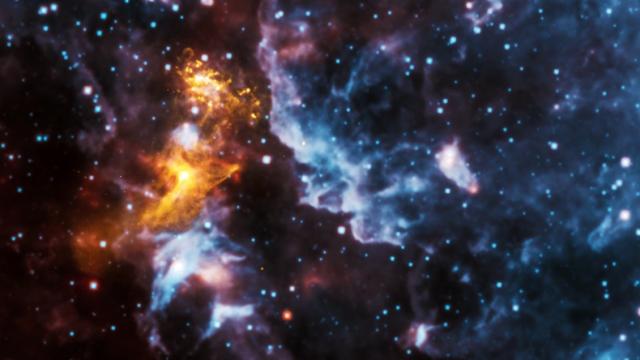It’s only been a couple of weeks since the world cheered for the LIGO collaboration that made the first direct detection of gravitational waves from a binary black hole merger. Now, another group hunting for these spacetime ripples say they could detect very low-frequency gravitational waves using existing radio telescopes in the next three years.
Successful detection will rest on crunching the combined data from a vast array of rapidly spinning neutron stars known as pulsars — the more, the better. That’s the conclusion of a new paper, just published in Astrophysical Journal Letters by members of the NANOGrav (North American Nanohertz Observatory for Gravitational Waves) collaboration. NANOGrav is part of a larger international consortium that also includes the European Pulsar Timing Array and the Parkes Pulsar Timing Array in Australia.
As we reported previously, there’s actually an entire spectrum of gravitational waves, much like there are many different kinds of light of varying wavelengths in the electromagnetic spectrum. NANOGrav scientists are hunting for very low frequency gravitational waves in the 1 to 10 nanohertz regime; LIGO’s sensitivity is in the kilohertz (audible) portion of the spectrum.
So the two collaborations would sense gravitational waves from different phases of a black hole binary merger, for example. “LIGO sees the very end of the merger when the binaries are very close together,” Chiara Mingarelli, a gravitational wave astrophysicist at Caltech, told Gizmodo when the LIGO announcement was made. “We would see them earlier in the spiral phase, when they’re just starting to orbit each other.”
Pulsars are formed when stars more massive than the Sun explode and collapse inward, spinning faster and faster as they shrink. They also give off powerful blasts of radiation as they rotate, just like the beam of a lighthouse, that are detected as pulses of light by radio telescopes back on Earth. NANOGrav relies on pulsar data collected by the Arecibo Observatory in Puerto Rico and the Green Bank Telescope in West Virginia.
And those periodic rotations are remarkably precise — as accurate as an atomic clock until quite recently, at least for the class of pulsars emitting pulses in the millisecond regime. This makes them an ideal cosmic detector of gravitational waves. For NanoGRAV, the smoking gun would be a kind of shimmering effect. The pulses should arrive at the same time, but if they’re hit by a gravitational wave, they will arrive slightly earlier or later, because spacetime will shrink or stretch as the wave passes through.
According to Mingarelli, NANOGrav is hunting for low-frequency gravitational waves from two sources. One source is supermassive black hole binary systems — bigger black holes bigger than those LIGO is targeting, believed to be at the centre of galaxies. When the galaxies merge, so do the black holes at their centres, creating powerful gravitational waves.
Another target source is the random background created by all the gravitational waves ever emitted by merging galaxies since the early days of the universe. “Detecting this signal is possible if we are able to monitor a sufficiently large number of pulsars spread across the sky,” lead author Stephen Taylor of NASA’s Jet Propulsion Laboratory said in statement. The worst case scenario, according to the latest analysis, is detection within ten years.
That’s at odds with a paper published in Science last year by the Australian contingent, who reported their failure to detect any significant signals with their array and called into question the feasibility of this entire approach. The PPTA uses data from just four pulsars, all of them excellent sources. In a short response posted to the arXiv Monday night, the NANOGrav team said this was not surprising, because the PPTA needs more pulsars.
Specifically, they estimate that the PPTA has a less than 10 per cent chance of detecting any signal in the next 20 years if they rely on just their four pulsars. “We need more ‘good’ pulsars and fewer ‘excellent’ ones,” Mingarelli told Gizmodo. “If we use large arrays of pulsars, like the International Pulsar Timing Array, then we will likely detect the gravitational wave background in less than ten years.”
The bodes well for NANOGrav’s chances, with its 54 (and counting) pretty good pulsars. “We’re like a spider at the center of a web,” co-author Michele Vallisneri said in statement. “The more strands we have in our web of pulsars, the more likely we are to sense when a gravitational wave passes by.”
[Astrophysical Journal Letters]
Top image: Spinning neutron star (pulsar). Credit: NASA/CXC/SAO (X-Ray); NASA/JPL-Caltech (Infrared)
